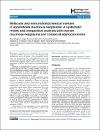Molecular and immunohistochemical markers in appendiceal mucinous neoplasms: A systematic review and comparative analysis with ovarian mucinous neoplasms and colorectal adenocarcinoma

View/
Date
2025Author
Elsayed, BaselElshoeibi, Amgad Mohamed
Elhadary, Mohamed
Al-Jubouri, Abdullah M.
Al-Qahtani, Noof
Vranic, Semir
Al-Saady, Rafif
...show more authors ...show less authors
Metadata
Show full item recordAbstract
Introduction. Appendiceal mucinous neoplasms (AMNs) represent a rare and diagnostically challenging group of tumors. This systematic review aims to summarize the reported molecular and immunohistochemical markers (IHC) associated with AMNs and compare them with ovarian mucinous neoplasms (OMNs) and colorectal adenocarcinoma (CRC). Methods. A comprehensive search was performed in PubMed/MEDLINE/PMC, Scopus, Embase, and Web of Science databases to identify studies looking at IHC and molecular markers in AMNs. Chi-squared and Fisher’s exact tests were utilized to compare the marker expression across different tumor types. Results. We identified 27 articles reporting several potential biomarkers for distinguishing between different subtypes of AMNs. Mutations in KRAS, GNAS, and RNF43 emerged as notable biomarkers, with KRAS mutations being the most prevalent across all subtypes. Additionally, p53 IHC overexpression was associated with higher tumor grades. When comparing AMNs with OMNs, we observed a higher prevalence of CK20, CDX2, SATB2, and MUC2 IHC expression, as well as KRAS and GNAS mutations, in AMNs. Conversely, CK7 and PAX8 IHC expression were more prevalent in OMNs. Comparing AMNs with CRCs, we found a higher prevalence of TOPO1 and PTEN IHC expression, as well as KRAS and GNAS mutations, in AMNs. Conversely, nuclear β-catenin IHC expression, as well as TP53, APC, and PIK3CA mutations, were more prevalent in CRCs. Conclusion. This systematic review identified possible markers for distinguishing AMNs and differentiating between AMNs, OMNs, or CRCs.
Collections
- Medicine Research [1891 items ]

